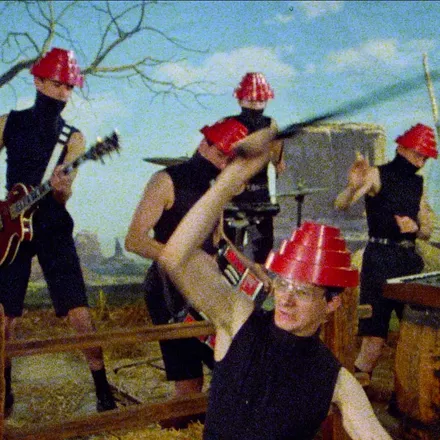“Why?” It’s an obvious question, when pondering the “upgraded” theatrical re-release of older films. But it’s really only half of the question.
This week, Disney/Pixar sends 2003’s Finding Nemo back into theaters in 3-D; it also marks the end of a special weeklong run of 1981’s Raiders of the Lost Ark in IMAX theaters. Over the past few years, we’ve seen multiple animated films converted to 3-D (Toy Story and Toy Story 2, The Lion King), as well as Titanic in IMAX 3-D and the first of a planned 3-D rerelease of all the Star Wars films. They’re all beloved films, films that made a mint when they were first in theaters. They were, each in their own way, classics in their original form.
So, pondering the first part of our “why” equation: Why re-release them? And we all intuitively know that the answer—since it’s the answer to virtually every question where Hollywood is concerned—is money. Studios have latched onto the premium price of 3-D ticket sales as a crucial income stream, and re-releases are an easy way to squeeze a few extra bucks out of a pre-existing property.
Sometimes there’s an additional promotional component involved, as well. The IMAX Raiders precedes the Sept. 18 release of the Indiana Jones films on Blu-ray; the 3-D re-release of Toy Story and Toy Story 2 was a lead-in to Pixar’s Toy Story 3, just as the planned Monsters, Inc. 3-D re-release later this year will help tease for next summer’s prequel, Monsters University. Even if the re-releases themselves do only so-so business, they can be savvy ways to increase awareness for what’s coming next.
There is, of course, the other part of the “why,” as well: Why would audiences go out to see them? In the age of DVD, when pirated torrents slice into the business of even brand-new films, why are folks willing to buy a ticket for something they’ve already seen—and, perhaps nearly as likely, already own?
The answer isn’t just 3-D, though certainly that experience continues to be a selling point for some viewers. My longstanding antipathy for 3-D is no secret to regular readers of this space, but there are unique visual delights in the 3-D version of Finding Nemo. While there may be a few in-your-face effects like a chomp from Bruce the shark, it’s mostly an opportunity to marvel at the detailed, tactile worlds created by Pixar’s animators. Marlin’s individual scales shimmer in the shifting light; Nemo’s fish-tank prison in the dentist’s office is adorned with fingerprint smudges; the seagulls chasing Marlin, Dory and their pelican pal plow through a boat’s sail that’s covered in ripples of texture. Every once in a while, such a rerelease can turn an old favorite into an entirely new experience.
But, just as often, it’s about the opposite: recapturing an old experience. Before the advent of home video, Disney re-released its animated “classics” every seven years or so, allowing a new generation of parents to introduce their children to their own childhood favorites. In many cities, vintage films get big-screen showings in their original form—as the Tower Theatre and Brewvies do locally on a regular basis— allowing for raucous experiences of old crowd favorites. Even multiplexes are regularly providing special screenings of classics like The Godfather, The Birds and Lawrence of Arabia under the Fathom Events banner.
Yes, it’s nostalgia—but it’s also something slightly more complex. It’s a recognition, it seems, that the theatrical experience is still special to us. Forgive the rhapsodizing, like George Will gushing about the purity of baseball, but we go to the movies not just to see a movie; we go also to be at the movies—to wait for the moment when the lights go down, the world is shut out and we allow ourselves to be immersed in a story and share that experience with a crowd. The generation that has grown accustomed to watching movies on computer screens and iPads still goes out to the movies, and not just because it’s something to do with friends on a Friday night. It’s an entirely different way of watching—one that feels grander and more communal.
It’s easy to be cynical about seeing a decade-old (or more) movie pop up in theaters, as though the 3-D might just as well include a hand plunging out of the screen to yank $15 more dollars out of your wallet. But maybe, every once in a while, these re-releases might be a better choice than some mediocre new release. These, after all, are the movies that remind you why you love going to the movies in the first place.
More by Scott Renshaw
-
Film Reviews: New Releases for March 28
A Working Man, The Woman in the Yard, The Penguin Lessons, Death of a Unicorn, Audrey's Children
- Mar 27, 2025
-
Theater preview: Plan-B Theatre Company's The Beatrix Potter Defense Society
Local playwright Janine Sobeck Knighton explores how isolation inspired the beloved author.
- Mar 26, 2025
-
Film reviews: THE PENGUIN LESSONS, DEATH OF A UNICORN
Fumbling the potential-filled question of what to do when confronted with a broken system
- Mar 26, 2025
- More »
Latest in Film Reviews
Readers also liked…
-
Sundance 2025 wrap-up plus February special screenings
Uncertainty about the future location shifts focus away from the movies
- Feb 5, 2025








